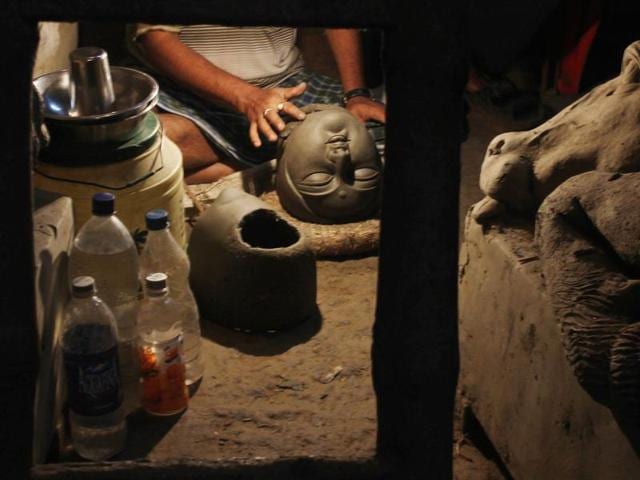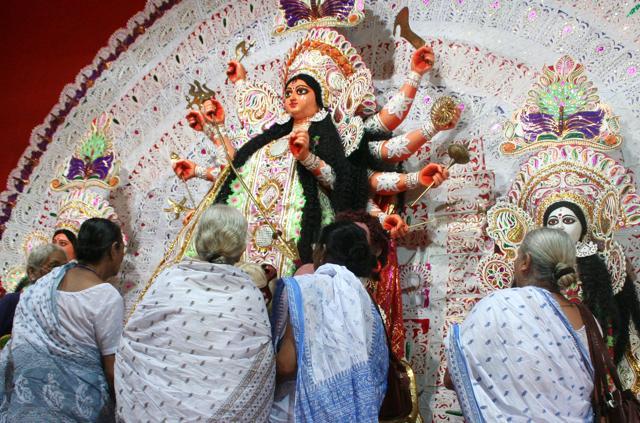Going green, the Puja way
The face of Bengal’s biggest festival has changed with more and more organisers in Kolkata and the interiors of Bengal adopting environment-friendly measures to reduce pollution and promote public awareness on green hazards.
The year was 2007. Then state environment minister, Sailen Sarkar, was having an informal chat with a few environment experts and some senior Kolkata-based journalists over a cup of tea in his chamber one evening. The topic of discussion was as informal as the meeting — what could be done about the rising pollution levels in the city?

Experts and journalists pointed out that with no checks and balance, the pollution was shooting up every day. The levels were particularly high during the festival. During Durga Puja, thousands of lights gild the pandals in and across the city. These consume thousands of units of power which comes mainly from the coal-based thermal power plants. This further contributes to rising pollution levels.
The idol-makers of Kumortuli were, at the time, using paints laced with led and other toxic chemicals. As the idols were immersed in the Hooghly, the toxic chemicals melted into the water leading to pollution. Furthermore, the random and unrestricted use of plastics, sound and crackers added to the environmental hazard.

It was then that the idea of launching a green campaign during the Durga Puja was pitched in the meeting. Though there wasn’t much hope at the time that the proposal would be followed up and implemented in earnest or be taken seriously.
The experts told the minister that if companies could ride the Puja bandwagon to capture the imagination of consumers while they are out pandal-hopping, why can’t the idea of a clean and green environment and an eco-friendly Puja take shape at a time when the festive frenzy hits the proverbial crescendo?
Read: Tale of two women: Mother Teresa and Ma Durga
The minister latched on to the idea and even assured his department’s full support if any initiative is taken to make Bengal’s biggest festival — the Durga Puja — a clean and green one.
As these discussions and initiatives were gradually gaining momentum, a professor of biochemistry, Krishnajyoti Goswami, who was heading the National Referral Centre for Lead Poisoning in India (West Bengal Chapter) at the time, commissioned a study that brought out how paints laced with lead and used for painting the idols were posing grave risks to the environment.
Equipped with this report, environment activists and pollution experts hit the roads. The first Puja to take up an environment-related theme was the puja at FD Block in Salt Lake. That was the start of the green revolution that gradually left an indelible imprint on Bengal’s biggest festival.

A city-based NGO, Environment-Governed Integrated Organisation (EnGIO), announced an award for the best of all ‘Green’ pujas. In the first year itself, as many as 60 puja organisers applied for the award. The initiative was supported by the West Bengal Pollution Control Board.
Thereafter, environment-related themes such as climate change, energy conservation, noise pollution, plastic and immersion made their presence felt at Puja pandals across the city. Puja organisers, not just in the city and across the state, joined the revolution and started planning their themes on these lines. Related topics such as safety and disaster management also turned into Puja themes.
Once the organisers of such big pujas as Suruchi Sangha in New Alipore, Ballygunge Cultural and others started working on these themes, there was no looking back. Experts claimed that at present, one out of every four pujas in the city and across the state are themed on environment-related topics.
Today, almost every award handed out to Puja organisers are judged on whether and to what extent they have adhered to environment-friendly norms. These awards, coupled with environment-friendly theme pujas, are gradually changing the face of Bengal’s biggest festival.
Simultaneously, the campaign for lead-free paints also gained momentum. Unlike other environment-friendly norms such as curbing use of plastic in selected areas, banning kanta tel (adulterated fuel) and phasing out pre-1993 vehicles which were enforced by the court and the government, it was a people’s movement that drove the change to lead-free paints.

Campaigns against paints laced with lead and chromium were actively carried out in Kumartuli and also by puja organisers. Initially, there was resistance from the artisans as they claimed that lead-free paints could result in rise in the price of idols. Many voiced fear of the idols losing out on lustre and glossy finish in the bargain.
Lending a boost to the green cause, the state pollution control board got leading paint manufacturers to distribute over 150 litre of ‘green’ paint among artisans in idol-making hubs at Kumartuli, Garia, Canal East Road, Metiabruz and Howrah in 2011.
At a meeting with 16 paint manufacturing companies, the experts pointed out that to bring about a behavioural change, they first needed the artisans to use the paint. And the best way to do so was to distribute it for free during Durga Puja, Kali Puja and Jagaddhatri Puja. The response from both the artisans and the paint companies was overwhelming. Some paint companies even organised workshops with the artisans to sensitise them on environmental hazards and encourage them to switch to green paints.
Apart from distributing “green” paint in Kolkata and Howrah before the Pujas, the PCB also took the initiative to Chandernagore before Jagaddhatri Puja and Naihati before Kali Puja.
Awareness campaigns targeting puja organisers paid off. As the organisers started demanding idols made with lead-free paints, the artisans were left with little option but to switch to such paints.
In 2015, a survey of the city’s leading pujas — conducted by Kolkata Municipal Corporation (KMC), Kolkata Port Trust (KoPT) and EnGIO suggested that more than 70% of the Kolkata’s top draws had switched to lead-free paint.
But that was not all. After doing away with the polluting lead paints, the chorus to make the pujas more environment-friendly by using LED lights as opposed to the existing ones, got shriller.

The organisers gradually started displaying their lighting skills with the help of LED lights. At such top pujas as Ekdalia Evergreen, Singhi Park Durgotsav and Md Ali Park — that draws revellers aplenty for their dazzling display of lights — the organisers gradually shifted to LED lights.
LED lights consume less power than the regular ones. Those switching to LED lights derived instant benefits. The power consumption, which used to shoot up manifold during the Pujas, came down significantly. This was despite the fact that the number of pujas increased over the years.
As the majority of our power supply still comes from coal-based thermal power plants, more consumption lead to more pollution. However, the advent of LED lights helped curb both power consumption and pollution.
Also, the efforts made by the Kolkata Municipal Corporation (KMC) and other civic bodies across the state to pull out the idol structures soon after they are immersed into the water, made a difference. Every year, the KMC makes elaborate arrangements during immersion in the Hooghly to prevent pollution.
While separate make-shift bamboo structures are erected near the ghats where those, leading immersion processions, could dump flowers, the KMC deputes workers to pull out the idol structures after immersion. The Hooghly is restored to its normal pristine self within 48 hours of immersions.

The first such initiative was taken up by the residents of Chandernagore in Hooghly. It was a people’s initiative supported by the civic body.
In time, the initiative spreads to other municipalities. Civic boards like the one at Naihati municipality took it to another level. In Naihati, the idols are not even taken to the ghats for immersion. A huge screen was erected, behind which hose pipes were used to melt the idols into a mound of mud.
A few puja organisers in Kolkata have approached the KMC authorities asking to be allowed to follow the same procedure. However, not much has come of it as yet.
The initiative to make the Pujas clean and green is now set to be taken to every single community in the city. A city based NGO recently tied up with the KMC to launch a campaign aimed at keeping the neighbourhoods as clean and green as the pandals. Awards for the best eco-friendly para (locality), which implements ban on plastic, segregates waste, manages t e-waste and maintains its greenery, have also been proposed.




